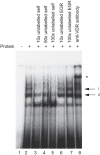Expression of the multiple sclerosis-associated MHC class II Allele HLA-DRB1*1501 is regulated by vitamin D
- PMID: 19197344
- PMCID: PMC2627899
- DOI: 10.1371/journal.pgen.1000369
Expression of the multiple sclerosis-associated MHC class II Allele HLA-DRB1*1501 is regulated by vitamin D
Abstract
Multiple sclerosis (MS) is a complex trait in which allelic variation in the MHC class II region exerts the single strongest effect on genetic risk. Epidemiological data in MS provide strong evidence that environmental factors act at a population level to influence the unusual geographical distribution of this disease. Growing evidence implicates sunlight or vitamin D as a key environmental factor in aetiology. We hypothesised that this environmental candidate might interact with inherited factors and sought responsive regulatory elements in the MHC class II region. Sequence analysis localised a single MHC vitamin D response element (VDRE) to the promoter region of HLA-DRB1. Sequencing of this promoter in greater than 1,000 chromosomes from HLA-DRB1 homozygotes showed absolute conservation of this putative VDRE on HLA-DRB1*15 haplotypes. In contrast, there was striking variation among non-MS-associated haplotypes. Electrophoretic mobility shift assays showed specific recruitment of vitamin D receptor to the VDRE in the HLA-DRB1*15 promoter, confirmed by chromatin immunoprecipitation experiments using lymphoblastoid cells homozygous for HLA-DRB1*15. Transient transfection using a luciferase reporter assay showed a functional role for this VDRE. B cells transiently transfected with the HLA-DRB1*15 gene promoter showed increased expression on stimulation with 1,25-dihydroxyvitamin D3 (P = 0.002) that was lost both on deletion of the VDRE or with the homologous "VDRE" sequence found in non-MS-associated HLA-DRB1 haplotypes. Flow cytometric analysis showed a specific increase in the cell surface expression of HLA-DRB1 upon addition of vitamin D only in HLA-DRB1*15 bearing lymphoblastoid cells. This study further implicates vitamin D as a strong environmental candidate in MS by demonstrating direct functional interaction with the major locus determining genetic susceptibility. These findings support a connection between the main epidemiological and genetic features of this disease with major practical implications for studies of disease mechanism and prevention.
Conflict of interest statement
The authors have declared that no competing interests exist.
Figures




Similar articles
-
Contributions of vitamin D response elements and HLA promoters to multiple sclerosis risk.Neurology. 2012 Aug 7;79(6):538-46. doi: 10.1212/WNL.0b013e318263c407. Epub 2012 Jul 11. Neurology. 2012. PMID: 22786591
-
Vitamin D responsive elements within the HLA-DRB1 promoter region in Sardinian multiple sclerosis associated alleles.PLoS One. 2012;7(7):e41678. doi: 10.1371/journal.pone.0041678. Epub 2012 Jul 25. PLoS One. 2012. PMID: 22848563 Free PMC article.
-
Interaction of vitamin D receptor with HLA DRB1 0301 in type 1 diabetes patients from North India.PLoS One. 2009 Dec 2;4(12):e8023. doi: 10.1371/journal.pone.0008023. PLoS One. 2009. PMID: 19956544 Free PMC article.
-
Multiple sclerosis, vitamin D, and HLA-DRB1*15.Neurology. 2010 Jun 8;74(23):1905-10. doi: 10.1212/WNL.0b013e3181e24124. Neurology. 2010. PMID: 20530326 Free PMC article. Review.
-
HLA class II sequences and genetic susceptibility to insulin dependent diabetes mellitus.Baillieres Clin Endocrinol Metab. 1991 Sep;5(3):395-411. doi: 10.1016/s0950-351x(05)80138-7. Baillieres Clin Endocrinol Metab. 1991. PMID: 1909860 Review.
Cited by
-
The fine balance of chemokines during disease: trafficking, inflammation, and homeostasis.Methods Mol Biol. 2013;1013:1-16. doi: 10.1007/978-1-62703-426-5_1. Methods Mol Biol. 2013. PMID: 23625489 Free PMC article. Review.
-
Integration of Biomarkers Into a Signature Profile of Persistent Traumatic Brain Injury Involving Autoimmune Processes Following Water Hammer Injury From Repetitive Head Impacts.Biomark Insights. 2018 Oct 29;13:1177271918808216. doi: 10.1177/1177271918808216. eCollection 2018. Biomark Insights. 2018. PMID: 30397383 Free PMC article. Review.
-
Confirmation of association between multiple sclerosis and CYP27B1.Eur J Hum Genet. 2010 Dec;18(12):1349-52. doi: 10.1038/ejhg.2010.113. Epub 2010 Jul 21. Eur J Hum Genet. 2010. PMID: 20648053 Free PMC article.
-
Association of UV radiation with multiple sclerosis prevalence and sex ratio in France.Neurology. 2011 Feb 1;76(5):425-31. doi: 10.1212/WNL.0b013e31820a0a9f. Neurology. 2011. PMID: 21282589 Free PMC article.
-
A Brief Review of the Effects of Vitamin D on Multiple Sclerosis.Front Immunol. 2020 May 6;11:781. doi: 10.3389/fimmu.2020.00781. eCollection 2020. Front Immunol. 2020. PMID: 32435244 Free PMC article. Review.
References
-
- Noseworthy JH, Lucchinetti C, Rodriguez M, Weinshenker BG. Multiple sclerosis. N Engl J Med. 2000;343:938–952. - PubMed
-
- Ebers GC. Environmental factors and multiple sclerosis. Lancet Neurol. 2008;7:268–277. - PubMed
-
- Ramagopalan SV, Ebers GC. Genes for multiple sclerosis. Lancet. 2008;371:283–285. - PubMed
-
- Lundmark F, Duvefelt K, Iacobaeus E, Kockum I, Wallstrom E, et al. Variation in interleukin 7 receptor alpha chain (IL7R) influences risk of multiple sclerosis. Nat Genet 2007 - PubMed
-
- Hafler DA, Compston A, Sawcer S, Lander ES, Daly MJ, et al. Risk alleles for multiple sclerosis identified by a genomewide study. N Engl J Med. 2007;357:851–862. - PubMed
Publication types
MeSH terms
Substances
Grants and funding
LinkOut - more resources
Full Text Sources
Other Literature Sources
Medical
Research Materials

